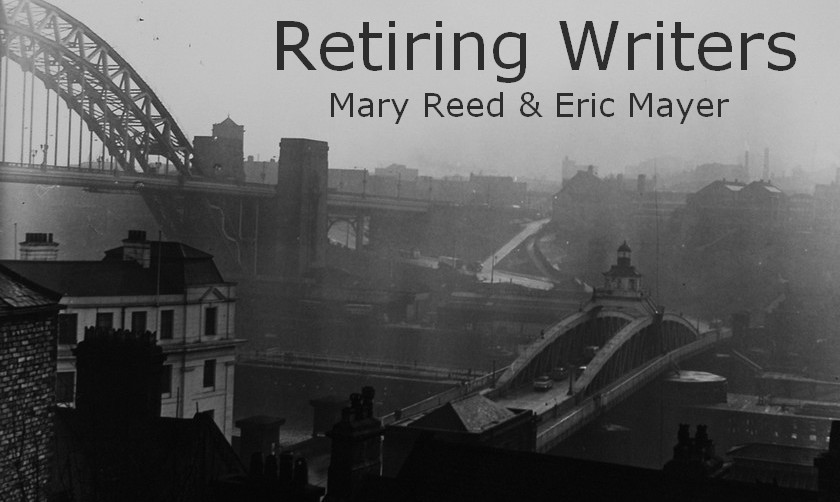I must be one of only a handful of mystery writers who've been aboard a steam train held up by a gang of desperadoes on horseback. I must confess however it was a put-up job during a special Age of Steam excursion. The bad guys strutted the length of the train after swinging aboard, glaring at all and sundry over red kerchiefs hiding their lower faces, much to our delight, only to be arrested by a brave sheriff and locked in the caboose for the return journey to the home station. There the entire gang were incarcerated in a small cell where small fry jeered at them while adults congratulated the law man on his sterling work keeping the railway safe from marauders. As that nice Mr Google informed me, the very day I began this essay was Paddington Bear's 50th birthday, reminding me a while long ago I stumbled over a reproduction of William Powell Frith's The Railway Station (1862), depicting a train getting ready to leave Paddington Station. See above.
There's a mystery connection. In the far right of the painting wo well-known Scotland Yard detectives, who have been identified as Detective-Sergeants Michael Haydon (with the handcuffs) and James Brett (who's just laid his hand on a man's shoulder) are arresting a wanted fugitive, close enough to escaping the long arm of the law to have his foot on the step up into the carriage.
The trips I took on the steam trains in my youth were much more orderly -- well, apart from a drunken Irishman who insisted on entering a ladies only compartment at the start of one journey and a couple of men fighting at Newcastle's Central Station at the end of another.
The engine is hardly visible in Frith's painting, but it brought to mind when the train to Newcastle passed through Darlington's Bank Top Station, up to the mid l970s passengers could see a very similar engine, sitting on one of the platforms

Locomotion Number 1 is now displayed in the city's Head of Steam Museum in honour of its having pulled the first steam passenger train on the Stockton and Darlington Railway in the autumn of 1825. Apparently many who had turned out to see this amazing event confidently expected the strange and frightening new machine to explode, steam engines being basically boilers on wheels. It could not have been too comfortable a trip since the majority of the passengers travelled in open wagons formerly used for hauling coal, although dignitaries as usual got a better deal and were trundled along in a shed-like structure.
Those who remember travelling by steam usually wax nostalgic at the jerky drop of an up signal, recalling stray wisps of steam curling out from under enormous driving wheels while the great iron beast, resplendent in gleaming paint and well polished brass, sits poised to go after the fellow with the long-spouted oil can and peaked visor cap set at a rakish angle has swung down from the driver's cab and carried out his mysterious business. The smells of steam travel, coal smoke, steam, and hot oil, permeate memories of journeys begun after the heavy slamming of thick wooden doors by a waistcoated guard walking the platform along the length of the train, followed by shrill blasts on his whistle to announce an imminent departure and the distinctive chuffing as the train drew away. What a struggle it was to manage the wide leather strap lowering and raising door windows, the better to get cinders and soot on your person and allow steam and smoke to billow into the carriage when passing through tunnels! Carriage seating was upholstered in stiff, dusty moquette reminiscent of nothing so much as inexpensive carpeting, the walls above the seats adorned with advertising prints featuring maps and beautifully painted views of locations throughout the country encouraging travel and thus, in a promotional masterstroke, more business for British Rail. And can anyone who saw them forget those stern printed notices above the alarm chains in each carriage warning the penalty for misuse was five pounds?
It's a fair bet some of the most vivid steam age memories centre around the powerfully beautiful engines, the drivers' cabs displaying a multitude of tubing, gauges, levers, and stopcocks. Dame Rumour had it bacon and eggs were cooked on stokers' cleaned-off shovels, introduced into the firebox near the end of overnight runs. Lest passengers grew faint from hunger buffet cars provided more varied sustenance. Similar to that offered in railway refreshment rooms, it was solid, if often derided, fare featuring such staples as ham sandwiches with an occasional suspicion of a curl to their bread, stick to the ribs jam roly poly, pork pies, Scotch eggs, and slices of darkly mysterious Dundee cake, washed down with strong tea in thick-lipped cups. There were also fancier restaurant cars featuring the elegance of linen tablecloths and menus but alas for the profit columns in British Rail's ledgers, I rarely patronised either carriage for the trusty Reed thermos flask, a bag of crisps, and a couple of rolls of Rowntrees fruit gums saw me through the longest journey.




